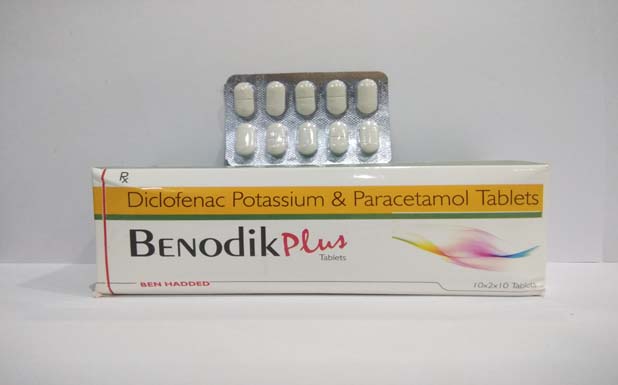The combination is used to relieve pain and fever. Diclofenac and paracetamolact as antipyeretic, analgesic and anti-inflammatory. Diclofenac and paracetamol are nonsteroidal anti-inflammatory drugs.
Muscles Pain
Toothache
Osteoarthritis
Bones And Joints Pain
Joint Pain
Headache
Rheumatoid Arthritis
Fever
Sore Throat
Paracetamol and diclofenac belongs to non-steroidal anti-inflammatory drugs which inhibits cyclooxygenase. Paracetamol is a derivative of acetaminophen, or paracetamol, with the molecular formula glycine, N, N-diethyl-,4-(acetylamino)phenyl ester. Paracetamol is a weak inhibition of COX-1 and COX-2, further inhibiting prostaglandin synthesis.
Diclofenac is a phenylacetic acid derivative also inhibiting COX-1 and COX-2 inhibits PG synthesis including PGE2 involved in modulation of nociception or pain sensation.
Diclofenac is well orally absorbed but only 50% is available in plasma due to high first pass metabolism. Volume of distribution for diclofenac was found to be 1.4 L/kg with 99% plasma protein binding. 65% of the dose is excreted in the urine and approximately 35% in the bile. The half-life of diclofenac is 25.8-33 h
Paracetamol is also well orally absorbed and volume of distribution is 1.29 l/kg. Protein binding of paracetamol is very negligible. It is metabolised in liver mainly by CYP enzymes. Paracetamol is mainly excreted in urine with a half-life of 3.6 hours.
Common side effect includes:
Shortness Of Breath
Abdominal Bleeding
Feeling Of Sickness
Stomach Inflammation
Increased Liver Enzymes In Blood
Vomiting
Not be taken along with blood thinners — such as Warfarin
Taking the following tablet with alcohol can cause liver damage
Active peptic ulcer
Should also be avoided by people with hypersensitivity.

| Diclofenac | 50 mg |
| Paracetamol | 325 mg |
